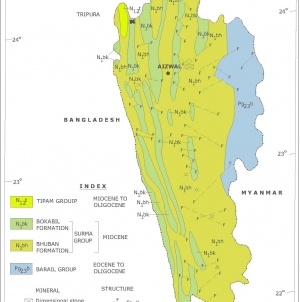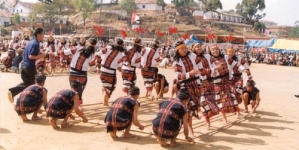-
Rajasthan - November 4, 2015
-
Haryana History - November 1, 2015
-
Haryana - November 1, 2015
-
Mizoram Minerals - March 3, 2015
-
Mizoram Hotels - March 2, 2015
-
Mizoram Culture - March 2, 2015
-
Mizoram Tourist Places - March 2, 2015
-
Mizoram History - March 1, 2015
-
Chhattisgarh Minerals - February 27, 2015
-
Chhattisgarh Hotels - February 27, 2015
HISTORICAL BACKDROP: The origin of the Mizos, like those of many other tribes in the North Eastern India is shrouded in mystery. The generally accepted as part of a great Mongoloid wave of migration from China and later moved out to India to their present habitat.
It is possible that the Mizos came from Shinlung or Chhinlungsan located on the banks of the river Yalung in China. They first settled in the Shan State and moved on to Kabaw Valley to Khampat and then to the Chin Hills in the middle of the 16th century.
The earliest Mizos who migrated to India were known as Kukis, the second batch of immigrants were called New Kukis. The Lushais were the last of the Mizo tribes migrate to India. The Mizo history in the 18th and 19th Century is marked by many instances of tribal raids and retaliatory expeditions of security. Mizo Hills were formally declared as part of the British-India by a proclamation in 1895. North and south hills were united into Lushai Hills district in 1898 with Aizawl as its headquarters.
The process of the consolidated of the British administration in tribal dominated area in Assam stated in 1919 when Lushai Hills along with some other hill districts was declared a Backward Tract under government of India Act. The tribal districts of Assam including Lushai Hills were declared Excluded Area in 1935.
It was during the British regime that a political awakening among the Mizos in Lushai Hills started taking shape the first political party, the Mizo Common People’s Union was formed on 9th April 1946. The Party was later renamed as Mizo Union. As the day of Independence drew nearer, the Constituent Assembly of India set up and Advisory Committee to deal with matters relating to the minorities and the tribals. A sub-Committee, under the chairmanship of Gopinath Bordoloi was formed to advise the Constituent Assembly on the tribal affairs in the North East. The Mizo Union submitted a resolution of this Sub-committee demanding inclusion of all Mizo inhabited areas adjacent to Lushai Hills. However, a new party called the United Mizo Freedom (UMFO) came up to demand that Lushai Hills join Burma after Independence.
Following the Bordoloi Sub-Committee’s suggestion, a certain amount of autonomy was accepted by the Government and enshrined in the Six Schedule of the constitution. The Lushai Hills Autonomous District Council came into being in 1952 followed by the formation of these bodies led to the abolition of chieftanship in the Mizo society.
The autonomy however met the aspirations of the Mizos only partially. Representatives of the District Council and the Mizo Union pleaded with the States Reorganization Commission (SRC) in 1954 for integrated the Mizo-dominated areas of Tripura and Manipur with their District Council in Assam.
The tribal leaders in the North East were laboriously unhappy with the SRC Recommendation s : They met in Aizawl in 1955 and formed a new political party, Eastern India Union (EITU) and raised demand for a separate state comprising of all the hill districts of Assam. The Mizo Union split and the breakaway faction joined the EITU. By this time, the UMFO also joined the EITU and then understanding of the Hill problems by the Chuliha Ministry, the demand for a separate Hill state by EITU was kept in abeyance.
FACTS AND LEGEND:
But folklore has an interests tale of offer. The Mizos, so goes the legend, emerged from under a large covering rock known as Chhinlung. Two people of the Ralte clan, known for their loquaciousness, started talking noisily while coming out of the region. They made a great noise which leg God, called Pathian by the Mizos, to throw up his hands in disgust and say enough is enough. He felt, too many people had already been allowed to step out and so closed the door with the rock.
History often varies from legends. But the story of the Mizos getting out into open from the nether world through a rock opening is now part of the Mizo fable. Chhinlung however, is taken by some as the Chinese city of Sinlung or Chinlingsang situated close on the sino-Burmese border. The Mizos have songs and stories about the glory of the ancient Chhinlung civilization handed down from one generation to another powerful people.
It is hard to tell how far the story is true. It is nevertheless possible that the Mizos came from Sinlung or Chinlungsan located on the banks of the river Yalung in China. According to K.S.Latourette, there were political upheavals in China in 210 B.C. when the dynastic rule was abolished and the whole empire was brought under one administrative system. Rebellions broke out and chaos reigned throughout the Chinese State. That the Mizos left China as part of one of those waves of migration. Whatever the case may have been, it seems probable that the Mizos mover from China to Burma and then to India under forces of circumstances. They first settled in the Shan State after having overcome the resistance put up by the indigenous people. Then they changed settlements several times, moving from the Shan State to Kabaw Valley to Khampat to Chin Hills in Burma. They finally began to move across the river Tiau to India in the Middle of the 16th Century.
The Shans had already been firmly settled in their State when Mizos came there from Chhinlung around 5th Century. The Shans did not welcome the new arrivals, but failed to throw the Mizos out. The Mizos had lived happily in the Shan state for about 300 years before they moved on the Kabaw Valley around the 8th Century.
It was in the Kabaw Valley that Mizos got the opportunity to have an unhindered interaction with the local Burmese. The two cultures met and the two tribes influenced each other in the spheres of clothing, customs, music and sports. According to some, the Mizos learnt the art of cultivation from the Burmese at Kabaw. Many of their agricultural implements bore the prefix Kawl which was the name given by the Mizos to the Burmese.
Khampat (now in Myanmar) is known to have been the next Mizo settlement. The area claimed by the Mizos as their earliest town, was encircled by an earthen rampart and divided into several parts. The residence of the ruler stood at the central block call Nan Yar (Palace Site). The construction of the town indicates the Mizos had already acquired considerable architecture skills. They are said to have planted a banyan tree at Nan Yar before they left Khampat as a sign that town was made by them.
The Mizos, in the early 14th century, came to settle at Chin Hills on the Indo-Burmese border. They built villages and called them by their clan names such as Seipui, Saihmun and Bochung. The hill and difficult terrain of Chin Hills stood in the way of the building of another central township like Khampat. The villages were scattered so unsystematically that it was not always possible for the various Mizo clans to keep in touch with one another.
MAUTAM FAMINE:
In 1959, Mizo Hills was devastated by a great famine known in Mizo history as ‘Mautam Famine’ . The cause of the famine was attributed to flowering of bamboos which consequent resulted in rat population boom in large numbers. After eating up bamboos seeds, the rats turned towards crops and infested the huts and houses and became a plaque to the Villages.
The havoc created by the rats was terrible and very little of the grain was harvested. For sustenance, many Mizos had to collect roots and leaves from the jungles. Others moved out to far away places edible roots and leaves from the jungles. Others moved out to far away places while a considerable number died of starvation.
In his hour of darkness, many welfare organization tried their best to help starving villagers to facilitate supplies to the remove villages, no organised porters, animal transport to carry the air-drop food supplies.
Earlier in 1955, Mizo Cultural Society was formed in 1955 and Laldenga was its Secretary. In March 1960, the name of the Mizo Cultural Society was changed to ‘Mautam front’ During the famine of 1959-1960, this society took lead in demanding relief and managed to attract the attention of all sections of the people. In September 1960, the Society adopted the name of Mizo National Famine Front (MNFF). The MNFF gained considerable popularity as a large number of Mizo Youth assisted in transporting rice and other essential commodities to interior villages.
INSURGENCY:
The Mizo National Famine Front dropped the word ‘Famine’ and a new political oraganisation, the Mizo National Front (MNF) was born on 22nd October 1961 under the leadership of Laldenga with the specified goal of achieving sovereign independence of Greater Mizoram. Large scale disturbances broke out on 28th February 1966 government installations at Aizawl, Lunglei, Chawngte, Chhimluang and other places simultaneously.
While the MNF took to violence to secure its goal of establishing a sovereign land, other political forces in the hills of Assam were striving for a separate state. The search for a political solution to the problems facing the hill regions in Assam continued.
The Mizo National Front was outlawed in 1967. The demand for statehood was gained fresh momentum. A Mizo District Council delegation, which met prime Minister Mrs Indira Gandhi in May 1971 demanded a full fledge state for the Mizos. The union government in its own offered the proposal of turning Mizo Hills into a Union Territory in July 1971. The Mizo leaders were ready to accept the offer on condition into a Union Territory in July 1971. The Mizo leaders were ready to accept the offer on condition that the status of U.T would be upgraded to statehood sooner rather than later. The Union Territory of Mizoram came into being on 21st January, 1972. Mizoram get two seats in Parliament, one each in the Lok Sabha and in the Rajya Sabha
BIRTH OF THE MIZORAM STATE:
Rajiv Gandhi’s assumption of power following his mother’s death signaled the beginning of a new era in Indian politics. Laldenga met the Prime Minister on 15th February 1985. Some contentious issues, which could not be resolved, during previous talks referred to him for his advice.
All trends indicated that neither the Centre nor the MNF would pass up the opportunity that has now presented itself to have a full lenient and flexible. New Delhi felt that Mizo problem had been dragging on for the long a time, while the MNF was convinced that bidding farewell to arms to live as respectable Indian Citizens was the only ways of achieving peace and development.
Statehood was a prerequisite to the implementing of the accord singed between the MNF and and the Union Government on 30 June 1986. The document was signed by Laldenga, on the behalf of MNF, and the Union Home Secretary RD Pradhan on behalf of the Government, Lalkhama Chief Secretary of Mizoram, too signed the agreement.
The MNF volunteers came out of their hiding and surrendered arms to makeshift bamboo huts up for the purpose at Parva and Marpara. A total of 614 activists gave themselves up in less than two weeks in July. Large quantities of small and big firearms including LMGs and rifles were received from them.
While the MNF kept its part of the bargain, the Centre initiated efforts to raise the status of Mizoram to a full fledged State. A constitution Amendment Bill and another to confer statehood on Mizoram was passes in the Lok Sabha on 5 August 1986.
The formalization of Mizoram State took place on 20th February, 1987.Chief Secretary Lalkhama read out the proclamation of statehood at a public meeting organised at Aizawl’s Parade Ground. Prime Minister Rajiv Gandhi flew in to Aizawl to inaugurate the new state. Hiteshwar Saikia was appointed as Governor of Mizoram.
PLACE OF INTEREST :
There are quite a number of places in Mizoram which may be described as ‘must see’ for tourist sports, anyone wishing to see a little more than the conventional tourist sports, anyone interests to know about the local culture and traditions is advised/expected to to do /visit some of the Mizoram’s historic memorials and fabled caves scattered all over the State. Traveling in Mizoram, not unlike in any other mountainous regions, is pain staking and little hazardous at times, but it has its own rewards.
Blue Mountain: The Highest peak in Mizoram, The Blue Mountain (Phawngpui) is situated in Chhimtuipui district overlooking the bend of the river Koldyne (Chhimtuipui) close on the state’s border with Myanmar. The peak 2,157 metre in height and encircled by bamboo groves at the top where there is a level ground of about 200 hectares, offers a grand view of the height hills and the meandering undulated valleys. The woods around are home to various species of beautiful and rare flora and fauna.
Pukzing Cave: The largest cave in Mizoram, it is situated at Pukzing village near Marpara in the district of Aizawl district (Mamit). Legend has it that cave was carved out of the hills with the help of only a hair pin by a very strong man called Mualzavata
Milu Puk: In the Mizo language, puk means a cave. Situated near Mamte village over 100 kms, from Lunglei town, the Milu Puk, which is a large cave, was found many years ago to contain heaps of human skeleton.
Lamsial Puk: Sitiuated near Farkawn village in Aizawl (Champhai) district, the cave as a silent testimony to a battle between two neighboring villages in which many lost their lives. The bodies of the fighters from village Lamsial are said to have been kept in the cave.
Kungawrhi Puk: Another cave in Aizawl district, it is situated on a hill between Farkawn and Vaphai Villages. According to the folktales, a beautiful young girl by the name of Kungawrhi was abducted and kept confined in the forlorn cave by some evil spirits when she was on her way to her husband’s village. Kungawrhi, however, was later rescued by her husband from the prison of the spirits.
Sibuta Lung: Erected about three hundreds years ago by a tribal chief, this memorial stone is named after him. The memorial offer a story of jilted love and lust for revenge. Having been rejected by a girl he fell headlong in love with, Sibuta went mad for revenge and decided to raise a memorial to himself in a manner which displayed an insane mind. A huge rock awash with the blood of three people sacrificed by Sibuta was carried over a distance of 10 km from the Tlawng river. Darlalpuii, a beautiful young girl, was crushed alive in a pit dug to erect the mausoleum. The memorial was raised over Darlai who lost her life under weight of the stone.
Phulpui Grave: A tale of love and tragedy also hangs by this grave located at Phulpui village in Aizawl District. Tualvungi, a raging beauty in her time, was married to Zawlpala, the Phulpui chief. She was later forced by circumstances to marry Phuntia, chief of another village. But Tualvungi could not forget her first love. She came to Phulpui years after Zawlpala’s death, hah a pit dug by the side of his grave and persuaded an old woman to kill and bury there.
Chhingpuii Memorial: Raised to the memory of a young woman called Chhingpuii who was exceedingly beautiful, it is situated between Baktawng and Chhingchhip villages on the Aizawl – Lunglei Road. Chhingpuii, born to an aristocratic family, selected Kaptluanga as her husband from among her many suitors. But her happiness was short-lived, as a war broke out afterwards. Chhingpuii was abducted and killed. A grief-stricken Kaptluanga took his own life. The stone memorial reminds one of the legendary love story of Chhingpuii and Kaptluanga.
Mangkhai Lung: A large memorial stone, it was erected about three hundred years ago at Champhai to the memory of a well-known Ralte chief, Mangkhaia.
Budha’s Image: An engraved image of Lord Buddha, with those of dancing girls on either side, was found at a site near Mualcheng Village about 50 km from Lunglei town. The site also has another stone slab on which some human footmarks and a few implements like spearhead and Dao are engraved. The area is close to the Chittagong Hill Tracts which was under which the Buddhist influence a few centuries ago. It is assumed that some visiting Buddhists from the Hill Tracts were responsible for the Buddha engraving.
Suangpuilawn Inscriptions: A stone slab lie by a stream at Suangpuilawn village in Aizawl district with strange words inscribed on it. The inscription remain to be deciphered till date. However, it is believed that the inscription were done by some people who inhabited the area in ancient times.
Thangliana Lung: Captian T.H.Lewin was one of the first Englishmen to come to Mizoram. The District Commissioner of the Chittagong Hills Tracts, who entered Mizoram by way of Demagiri (Tlabung) in 1865, became so popular with the local tribesmen that as a mark of respect, he was called Thangliana which meant ‘greatly famous’. He lived with the Mizos for nine years and authored the first Lushai book. His memorial stone at Demagiri remains as evidence of the extent of his popularity with the Mizos.



















